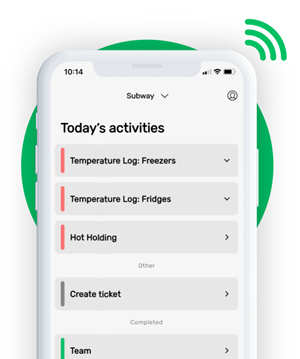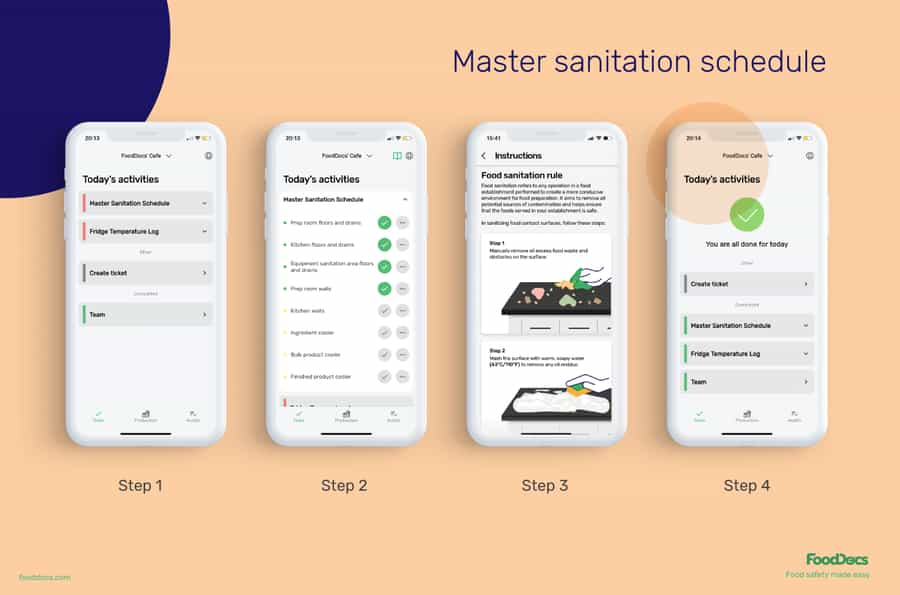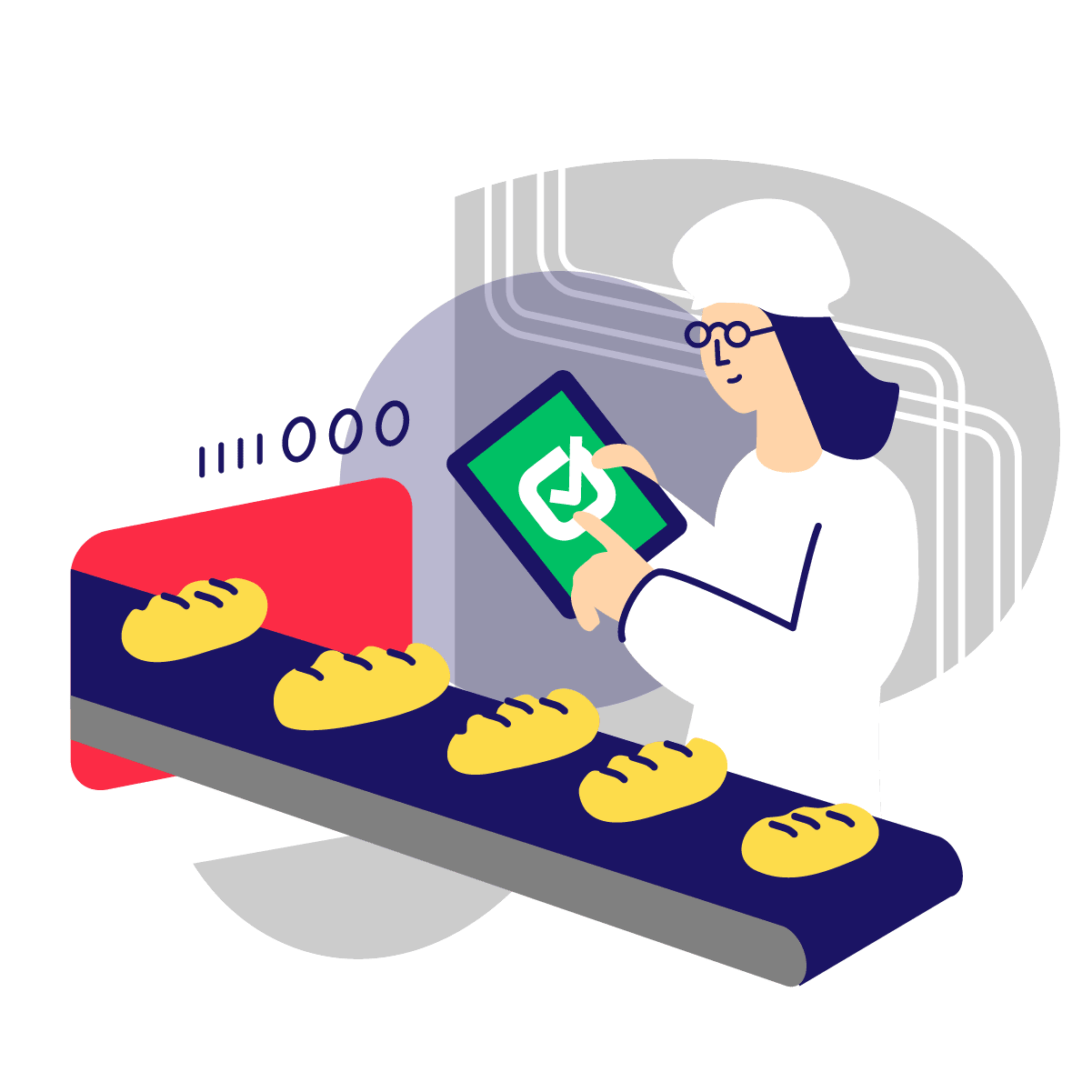RESTAURANT DEEP CLEANING CHECKLIST


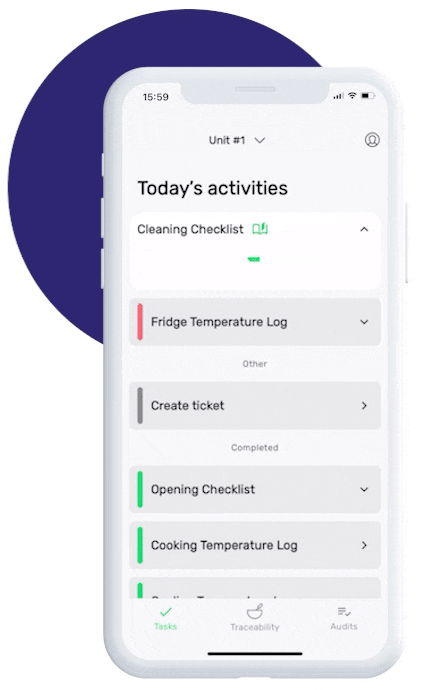
This is how our Digital Food Safety platform saves 20% of your time on daily tasks:
- Get upcoming task notifications
- Add data into the app
- Check the status of tasks in real-time

When food safety was still handled on paper, I typically spent a couple of hours per day getting the papers and going around checking or completing tasks… Now I can sit down and it's just all there in one place. It takes me 5-10 minutes.
Ruth B.
Store Manager
| Company name: Your company | _ |
| Daily | Mon | Tue | Wed | Thu | Fri | Sat | Sun | Notes |
|---|
| Weekly | Mon | Tue | Wed | Thu | Fri | Sat | Sun | Notes |
|---|
| Monthly | Mon | Tue | Wed | Thu | Fri | Sat | Sun | Notes |
|---|
Restaurant deep cleaning
Among the many preventive food safety practices, cleaning is one of the most effective preventive measures there is. Food establishments are some of the most meticulously cleaned businesses there could be. This is because food safety significantly depends on regular restaurant deep cleaning. Food businesses are expected to uphold strict cleaning standards in their space and food prep equipment.
Restaurant deep cleaning involves several cleaning practices that must be done regularly, sometimes even on a daily basis. Consistently applying the correct cleaning procedures ensures that your food processing facility meets food and health codes and laws established by food safety agencies.
In this article, we discuss the importance of restaurant deep cleaning process and how you can help your team remember the cleaning tasks that need to be done every day.
What is restaurant deep cleaning?
Restaurant deep cleaning is a comprehensive, top-to-bottom sanitation process that goes beyond routine daily cleaning. While daily cleaning helps maintain surface-level hygiene, deep cleaning targets hidden grime, grease buildup, and hard-to-reach contamination hotspots that can lead to foodborne illness or pest infestations.
Unlike regular cleaning tasks, deep cleaning involves disassembling kitchen equipment, moving heavy appliances, and sanitizing areas often missed in daily routines (e.g., vent hoods, grease traps, behind the fryer, and underneath storage shelves). It also includes sanitizing high-touch front-of-house (FOH) surfaces, such as restrooms, entry doors, and service counters.
The FDA Food Code recommends that food-contact surfaces be cleaned and sanitized frequently, especially when switching between tasks or ingredients, to prevent cross-contamination. Many local regulations now require deep cleaning of kitchen exhaust systems at least every 6 months.
By investing in regular deep cleaning, restaurants not only ensure food safety but also enhance the customer experience and prepare for health inspections.
Why restaurant deep cleaning matters now more than ever
Post-pandemic, cleanliness isn’t just a background task—it’s a customer expectation.
According to a study by TouchBistro, 91% of diners say they would avoid eating at a restaurant with a health code violation, and nearly one-third say they would never return to a visibly dirty establishment. Consumers now scrutinize restrooms, table conditions, and food handling more closely than ever before.
Health inspectors have also intensified their checks, and cleaning violations (e.g., moldy ice machines, dirty wiping cloths, and grease-laden hood vents) are among the most cited infractions.
A well-documented deep cleaning program signals professionalism, builds customer trust, and can help protect your business from fines or closures. It's also a critical component of food allergen management and cross-contamination prevention.
What areas are covered in restaurant deep cleaning?
To help food handlers remember which restaurant cleaning task needs to be done in a day, use a restaurant deep cleaning checklist.
In addition to kitchen equipment and prep surfaces, a comprehensive deep cleaning schedule should include:
- Front-of-house (FOH) areas: dining tables, menus, condiment stations, floors, restrooms, and entryways
- Back-of-house (BOH) zones: behind and underneath heavy equipment, walls, ceilings, drains, cold storage, and dishwashing areas
- Ventilation systems and hoods: clean filters and degrease interiors
- Food-contact tools: cutting boards, mixers, utensils, and containers
- Cleaning equipment: sanitize or replace mops, cloths, and sponges regularly
Neglecting these areas can contribute to pest infestations, bad odors, grease fires, and dangerous bacteria like E. coli and Salmonella.
A more exhaustive list of the the operations and items included in this type of restaurant deep cleaning checklist includes:
Daily cleaning checklist
- Wipe any food residue on walls, tables, food contact surfaces and food preparation tables
- Wipe and sanitize dining tables
- Clean exterior of oven and other cooking equipment (e.g., meat slicer, ice machine, and grill surface)
- Clean beverage dispensers
- Replenish condiment bottles (e.g., pepper shakers)
- Replenish paper towel dispensers
- Sanitize counters, steam tables, and prep tables or cooking surfaces
- Launder all bar towels, table cloths, floor mats, and aprons in washing stations
- Clean out trash cans/trash bins and empty recycling bins
- Clean and sanitize sinks
- Vacuum carpet and clean floor mats
- Sanitize entrance doors
- Refill soap dispensers
- Sanitize drip trays/drain pans
Weekly cleaning checklist
- Perform fixture and window cleaning
- Dust ceiling fans
- Flush floor drains with drain cleaner
- Sanitize espresso machines, coffee machines, and coffee makers
Monthly cleaning checklist
- Sweep and sanitize walk-in refrigerators
- Clean ovens
- Perform air vents and exhaust hood cleaning
- Clean and change hood filters
- Clean refrigerator coils
- Perform air duct cleaning
- Deep clean restrooms, sink drains, and handwashing areas
- Clean grease buildup from grease traps of the deep fryer
- Remove buildup on grout lines
- Delime dishwashers
- Replenish pest traps
Regular cleaning and sanitation procedures must be applied throughout the establishment. This means that every section of your restaurant must have a list of cleaning operations for maintenance, including special cleaning requirements.
Example of a Front-of-House (FOH) deep cleaning checklist
Restaurants typically choose to separate FOH and BOH deep cleaning tasks. While most cleaning efforts focus on the kitchen, the customer-facing front-of-house plays a critical role in your restaurant’s hygiene image.
Here’s a sample FOH deep cleaning checklist:
Daily FOH Tasks
- Sanitize dining tables, high chairs, and booster seats
- Wipe down laminated or reusable menus
- Clean and refill condiment bottles
- Sweep and mop dining floors
- Clean restrooms: toilets, sinks, door handles, mirrors, and soap dispensers
Weekly FOH Tasks
- Dust lighting fixtures, shelves, and window sills
- Deep clean glass doors and windows
- Disinfect reusable cloth napkins and seat cushions
Monthly FOH Tasks
- Shampoo carpets or deep clean hard floor surfaces
- Check for and remove cobwebs or ceiling stains
- Clean HVAC vents and ceiling fans
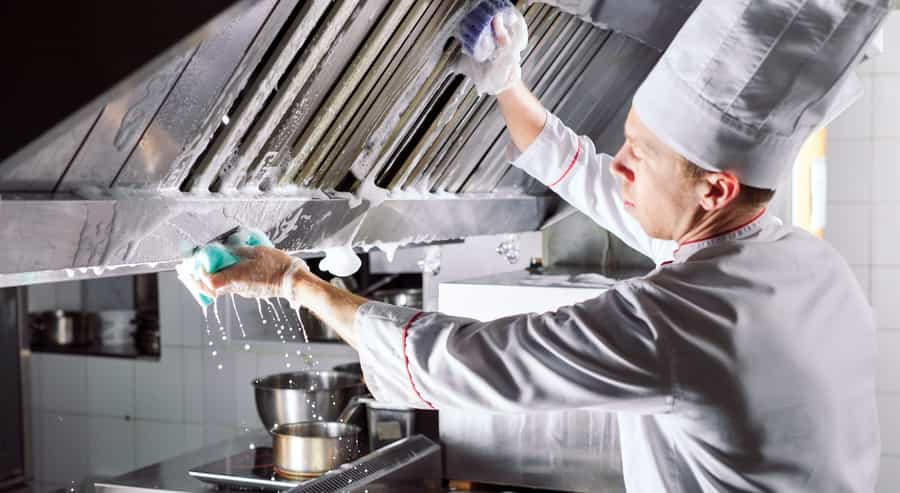
What supplies and tools are needed for a restaurant deep cleaning checklist?
The best cleaning plan can fall apart without the right tools. Here’s a recommended supply list to prepare for deep cleaning:
Cleaning agents
- Food-safe surface sanitizer (quaternary ammonium, bleach at 100 ppm, or enzyme-based)
- Degreaser for fryers, ovens, and hoods
- Glass cleaner for mirrors and doors
- Floor cleaning solution
- Drain cleaner and descaler
Tools and equipment
- Microfiber cloths (color-coded)
- Scrub brushes and scouring pads
- Mop and bucket (dual-bucket preferred)
- Broom and dustpan
- Vacuum cleaner (for carpeted areas)
- Squeegee for glass or tile surfaces
PPE and support items
- Rubber gloves and aprons
- Eye protection (for chemical use)
- Trash bags
- Extra sanitizer test strips
- Cleaning checklist log or app
Storing these supplies in a designated cleaning station ensures efficiency and supports food safety compliance.
What are the most common areas restaurants forget to deep clean?
Even well-meaning staff can overlook hidden contamination hotspots. Here are commonly missed spots that should be added to your checklist:
- Underneath heavy equipment like fryers and ovens
- Behind refrigerators and prep tables
- Ice machine interiors (can harbor mold and bacteria)
- HVAC vents and air returns
- Ceiling tiles above cook lines
- Refrigerator coils and drip pans
- Grease traps and exhaust hoods
- Dishwasher spray arms and filter baskets
Neglecting these areas can lead to buildup, bacteria growth, or even pest infestation. Build them into your weekly or monthly tasks.
Why do you need a deep cleaning checklist?
Industrial restaurant kitchen cleaning entails several stages of operations. It won't be a big surprise if food handlers occasionally forget one operation or two. The problem is that forgetting a cleaning task may result in very big problems.
For one, proper cleaning and sanitation tasks are essential operations that prevent the spread of viruses, cross - contamination, and a health crisis. They help ensure that the surfaces you use in preparing food are clean. A clean cooking area will not harbor any growth and spread of bacteria and other pathogens.
During any food and health inspection, a health inspector uses a related restaurant cleaning schedule checklist to evaluate your food business. A restaurant deep cleaning checklist can help your team do a more organized job and ensure that every spot and corner of your establishment is clean for the safety of staff and customer satisfaction.
What are some restaurant deep cleaning tips and best practices?
Even the best checklist fails without the right habits. Use these best practices to embed deep cleaning into your restaurant’s culture:
- Train for clarity: Teach staff the difference between cleaning, sanitizing, and disinfecting. Surfaces must be washed, rinsed, and then sanitized using a tested solution.
- Assign responsibility: Break the checklist into zones (prep, cook line, dish station, FOH) and assign them to staff or shifts.
- Follow top-down cleaning: Always clean from ceiling to floor and from back to front to avoid re-contaminating areas.
- Inspect and verify: Managers should sign off on deep cleaning logs daily. Digital systems like FoodDocs food safety monitoring software can automate this.
- Update regularly: Adjust your cleaning schedule based on customer traffic, menu changes, and new equipment or allergens introduced.
Consistency and accountability are key. Create a food safety culture where deep cleaning is part of the routine, not a panic before inspection.
Who needs a deep cleaning checklist?
Every food business needs a deep cleaning checklist. It is an essential tool that helps food safety teams cover all cleaning tasks. Since restaurants, food retailers, - producers, cafeterias, and food trucks have different cleaning tasks, a versatile restaurant kitchen cleaning checklist would be very helpful for your team.
With our restaurant deep cleaning checklists, you can easily add a unique and wide selection of operations to your business. Our checklist also acts as a template as we add the most common and essential tasks for cleaning and sanitizing. You can create a comprehensive cleaning program starting with this comprehensive checklist. A clean restaurant is a very big factor for any consumer to patronize your business.
Why is deep cleaning important?
A food establishment is very prone to accumulating dirt and, therefore, contamination. Foods, customers, and employees that go in and out of the establishment attract dirt. In addition, everyday operations also contribute to generating elements that may lead to contamination. As such, comprehensive cleaning strategies or cleaning routines must be implemented.
For example, fryers accumulate grease, windows gather dust, food debris buildup on tile floors, and table tops and prep area surfaces in commercial kitchens will always need sanitizing. Deep cleaning aims to create a good working environment for a food establishment.
Activities involved in deep cleaning can save your business from a food safety violation, negative review, or causing food poisoning. Some activities must be done daily, weekly, or monthly. For one, daily cleaning operations are very essential. The frequency of performing the tasks may translate to the rate of dirt accumulation.
Without a restaurant deep cleaning, your food business may become more prone to causing foodborne illness due to unsanitary working conditions and cross-contamination.
How can you help your team complete deep cleaning correctly?
Cleaning and sanitation to remove food hazards are invaluable operations when it comes to running a food business. You cannot run a food establishment with an unsanitary environment, or you will be the main attractant of food contaminations. All cleaning tasks for restaurant kitchens and service areas must be done to ensure consistent food safety.
The problem is that too many cleaning operations must be done. We're talking about a lot of operations in a day. Not to mention the monthly and weekly tasks. These operations must be performed on top of other food handling practices and hygiene rules.
Food cleaning and sanitation rules are too important to miss out on. So we encourage you to use our Free Restaurant Deep Cleaning Checklist. Place this checklist in a visible area such as a board with cleaning procedures that is accessible to all employees.
You can add any new operation at any time during service with our customizable template. This deep cleaning restaurant checklist is just one of our many food safety documents that can help you remind your team of important tasks for your food business. Check out more free food safety tools, such as our food sanitation rule poster. For more free checklists, templates, and posters, head over to our free HACCP plan template hub.
Aside from posting a cleaning checklist, success depends on training, tracking, and follow-up. Use these tactics to ensure consistent execution:
- Make the checklist visible and accessible at all times
- Provide clear instructions for each task (e.g., how to clean a grill safely)
- Assign tasks to specific team members by area or shift
- Schedule recurring cleaning tasks using tools like the FoodDocs app
- Conduct regular walk-throughs and surprise audits
- Celebrate successful inspections to reinforce good habits
Digital tools can streamline these efforts by sending reminders, logging completions, and making checklists mobile-friendly for teams in the kitchen.
Try digitizing your restaurant's deep cleaning checklist with food safety software
While a restaurant cleaning checklist can be very helpful for your entire restaurant, it may not be able to adapt to your constantly improving food business efficiently. Additionally, a checklist would generate too much paperwork for cleaning records if you have a business with a very large number of employees and cleaning tasks.

At FoodDocs, we have developed an automatic, digital solution for your cleaning and sanitation tasks. With our digital solution, you would not have to worry if your employees will remember the tasks that need to be done daily, weekly, and monthly. When you use our digital solution, you can get the following benefits:
- Our digital solution can help your employees remember every cleaning task with a smart notification system. This feature alerts the responsible cleaner to remind them of the cleaning or sanitation checklist task on time.
- You will get detailed instructions on correctly performing deep cleaning procedures to guide food employees in performing every task and ensure their effective application.
Deep cleaning checklist with training instructions
In addition, our digital Food Safety Management System can also help restaurant owners and managers save time:
- Switching to a digital food safety management system would only take an average of 15 minutes with our solution. All you need to do is answer a few basic questions about your business operations, and our artificial intelligence-powered system will do the rest.
- Using our digital solution's real-time dashboard, you can save 20% of your time supervising your team. With this feature, you will always be updated with the status of your business, including sanitation aspects.
- Save time finding and organizing all of your digital documents using the digital cloud storage that comes with our digital solution.
In addition to a more efficient cleaning operation, our digital solution can be your first step to becoming more sustainable. No more paper-based monitoring forms and checklists for your team.
Our digital solution was created by food safety experts with efficiency and high standards of food safety in mind. With our help, you can achieve food safety compliance in the foodservice industry with very little effort and protect your consumers effectively all the time.
Start your digital food safety journey by using our free, 14-day trial. With this trial, you can experience the convenience and effectiveness that our solution can bring to your team.
Frequently asked questions about restaurant deep cleaning
How often should a restaurant kitchen be deep cleaned?
What’s the difference between cleaning and sanitizing?
Cleaning removes visible dirt. Sanitizing uses chemicals or heat to kill bacteria on food-contact surfaces. Both are required steps in food-safe cleaning protocols (FDA Food Code).
How do I clean a commercial grill or fryer?
Turn off and cool equipment, disassemble if possible, and soak parts in degreaser. Scrub with a non-abrasive brush and rinse thoroughly. Reassemble only after drying completely. Fryers should be deep cleaned at least weekly.
Can I use bleach in a commercial kitchen?
Yes, but only at a safe concentration. Bleach can be used to sanitize food-contact surfaces at 50–100 ppm. Always rinse if instructed and never mix with other chemicals like ammonia.
What’s the best way to get staff to follow the cleaning checklist?
Assign clear responsibilities, train regularly, and track completion through digital tools like FoodDocs that send real-time reminders and maintain digital logs.
Do I need to keep records of deep cleaning?
Yes. Health inspectors may request cleaning logs to verify compliance. Keeping digital records or printed checklists signed by staff is a smart way to demonstrate food safety diligence.
